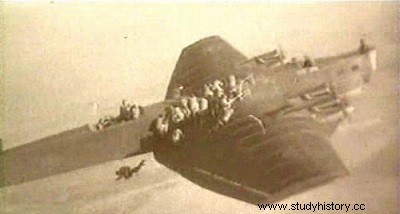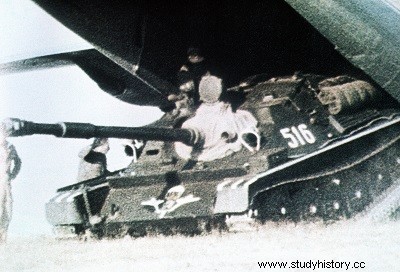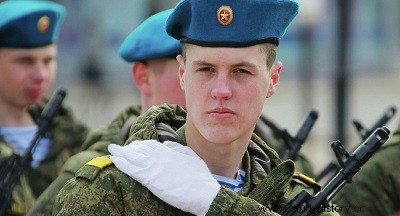
The Vozdouchno-dessantnye voïska or VDV "airborne troops") is a military body of airborne troops of the Russian army, ex-Soviet army.
On August 2, 1930, during maneuvers of the VVS in the Moscow Military District, 12 soldiers were parachuted from the wing of an airplane. We quickly realized the capabilities of using this type of assault.
Although it had shown the way during the 1930s in the deployment of airborne troops on a large scale, the USSR during the Second World War used such troops only rarely in the role for which they had been intended. designed. Opposite, the Germans used their transport planes mainly for the support of the army, their airborne units seeing themselves more and more engaged in an intervention role in the event of a desperate situation.
Soviet Russia had been among the pioneers of the airborne concept in the early 1930s, but after the execution of Marshal Tukhachevsky during the Stalinist purges that bloodied the later decade, airborne came under fire. early decline. Although airborne forces normally continued to exist, no doctrine was developed for their employment, and the Red Air Force was not equipped with any apparatus likely to be used for the mass dropping of airborne formations. This role fell to outdated bombers,
although they were in no way suited to it. The classic device for parachute drops remained the inadequate Tupolev TB-3 (still designated ANT-6) in its G-2 variant. With this device, paratroopers had to jump from a dorsal position halfway along the upper side of the fuselage. With such a method it was not possible to drop tight sticks.
In April 1942, when the Germans were preparing for the great offensive which was to carry their armies deep into the Caucasus, as well that at the tip of an eminently vulnerable
salient at Stalingrad, the Soviet airborne weapon was in decay. The largest formation, the Fourth Airborne Corps, had been virtually destroyed in a series of small operations that can only hardly be described as airborne. During the Russian retreat, from June to December 1941, many isolated units had been cut off by the German advance. To face this unforeseen situation, one transformed them into partisans and one charged them with operated on the German rear, their two principal areas of operations being the marshes of Pripet and the area of Smolensk where one had chances to have secure foundations. The Soviets pinned great hopes on the effectiveness of these partisans, and it is a fact that by the middle of 1943 they constituted a formidable threat which forced the Germans to engage combat formations in their rear to guard their long and vulnerable communication lines. But in the spring of 1942, these units could not do much because they were both poorly organized; ordered and supplied. The relatively few heavy aircraft possessed by the Soviets were used extensively to supply the partisans with personnel and materiel, and it was in the course of these operations that the Fourth Airborne Corps disappeared as an effective fighting formation. To hamper German preparations for their spring and summer offensives, partisans in the Smolensk region had been ordered to cut enemy lines of communication between that town and Vyazma. But the partisans were not capable of this; so, in order to support them, the Red Command decided to provide them with aid in the form of the Fourth Airborne Corps. The partisans obviously had no need for large formations, so the corps had to break up into small units which were distributed among the partisans. The operations against the German lines of communication were not successful, but there was no way to regroup the units of the IV Airborne Corps afterwards. Thus the Soviets lost their largest airborne strike force in futile detail operations between January and April 1942.
The Soviets remained committed to the principle of supporting the partisans with elements drawn from the airborne forces, and it is in this way that these went regularly while decreasing. But in the fall of 1943, they finally had the golden opportunity to strike a blow with their airborne. Following the crushing defeat suffered by the 6th Army at Stalingrad, the German armies were driven back in some disorder as far as the Dnieper. Realizing that if they could retain the initiative there was a good chance that the enemy could not re-establish strong positions in what was called the "Eastern Bulwark", the Soviets devised a bold operation . As their forces reached the Dnieper, where another army might have been expected to halt, huff and stage an assault crossing after careful preparation, they decided that a immediate crossing without major preparations would be made as soon as the river was reached. In summary, the Soviet armies wanted to attempt to "jump" the Dnieper before the German defenses could be organized.
On September 21 and 22, 1943, the 3rd Guards Armored Army and the Armies reached the river northwest of Dnepropetrovsk and immediately crossed it using whatever boats they
could find, rafts and anything that could float. The Germans were indeed surprised by the speed of the Soviet attack, but they recovered quickly and reacted with the vigor and initiative that characterized their counterattacks throughout the war.
Complete nonsense
As the battle was raging on the west bank of the Dnieper, the Soviet High Command finally thought it saw a golden opportunity to try, by an airborne operation, to put the Germans still in a position to overhang and thus to allow the two Armies mentioned above to continue their advance. Accordingly, on September 24, the 1st, 3rd and 5th Regts. Para were dropped at night in the area northwest of Kremenchug, about 40 km behind German lines. The plan was bold and perhaps deserved to be successful. Unfortunately for the Soviets, the decline into which their airborne had fallen led to disaster. Because if, on the one hand, the operation, in all probability, had already failed due to a lack of coordination between the airborne phase and the resumption of the offensive by the two Russian Armies concerned, the complete tactical ineptitude of the three Regts. airborne, on the other hand, doomed it to total failure. Untrained in this kind of operation, the pilots of the carrier planes scattered the three. Regs. over more than 40 km. Instead of regrouping as quickly as possible, the Russian paratroopers simply dug in where they were, in small detachments that were relatively ineffective and therefore posed no threat to the Germans. As they showed no aggressive intentions, the task of eliminating them was left to security and reserve troops, who exterminated them, not without some serious local fighting, for they showed their usual remarkable tenacity.
Adventure in the Far East
The only other occasion that saw the engagement of Soviet airborne troops occurred during the extraordinary campaign undertaken just at the end of the war against the Japanese in Manchuria, northern China, Korea and the Kuril Islands. To help the ground forces maintain a rapid advance, airborne landings were executed at a number of major towns along their axes of advance. As the official Russian source "The Soviet Army" recounted in its typical, terse and information-poor style:"On August 18 (1945) Japanese troops began to move into various areas, but many units unaware of a surrender or deliberately continued the resistance. Under these conditions, the speed of progress took on particular importance. It was decided to use airborne troops to seize some major cities... From August 18 to 24, airborne
troops landed in the cities of Ch'ang-Ch'un, Harbin, Kirin, Pyeong-yang, Dalny, Port-Arthur and a few others:“In summary, the Soviets had made intensive use of their airborne forces to secure a hold of the main cities of the region after the Japanese capitulation. And although it was not mentioned in "The Red Army", the airborne were also engaged in the capture of the island of Sakhalin. Three aerial landings were made there:August 23 at Oshiai, August 24 at Tojohara, and August 25 at Otomari.
With the exception of their landings in the Far East, the Soviets consequently did little use of their airborne forces during the Second World War. However, their successes in the Far East, as well as the lessons of German and Allied airborne operations convinced them that airborne forces could play an important role in a future conflict, so immediately after the end of hostilities they set about implementing on foot such forces.
Organization in 2007

They bring together 48,000 men organized into 4 divisions and a brigade commanded by General-Colonel Alexander Kolmakov. In 2014, it was announced that the workforce would be increased in 2019 to 72,000 people.
Divisions :
7th Guards Airborne Assault Division (Novorossiysk)
76th Guards Airborne Assault Division (Pskov)
98th Airborne Division (Ivanovo)
106th Airborne Division (Tula)

Squads:
31st (Ulyanovsk)
83rd (Ussourisk)
11th (Ulan-Ude)
Materials
These units have approximately 2,400 armored vehicles and 320 artillery pieces.
By the end of the 2010s, it is planned to supply new equipment, such as the BMD-4 infantry fighting vehicle (more than 1,500 announced in August 2014 for 2025), the BTR-D3 troop carrier (2,500 BTR-MD/BTR-D3 by 20251), the 125 mm gun 2S25 and the KamAZ-43501 truck. As well as the modernization of already existing equipment, namely:
BMD-3 (en)
ASU-57 and ASU-85
ZU-23-2 anti-aircraft gun
2S9 gun
Personal Armament :
AKS-74 assault rifle
RPK-74 machine gun
SVD sniper rifle
AGS-17 multi-shot grenade launcher
